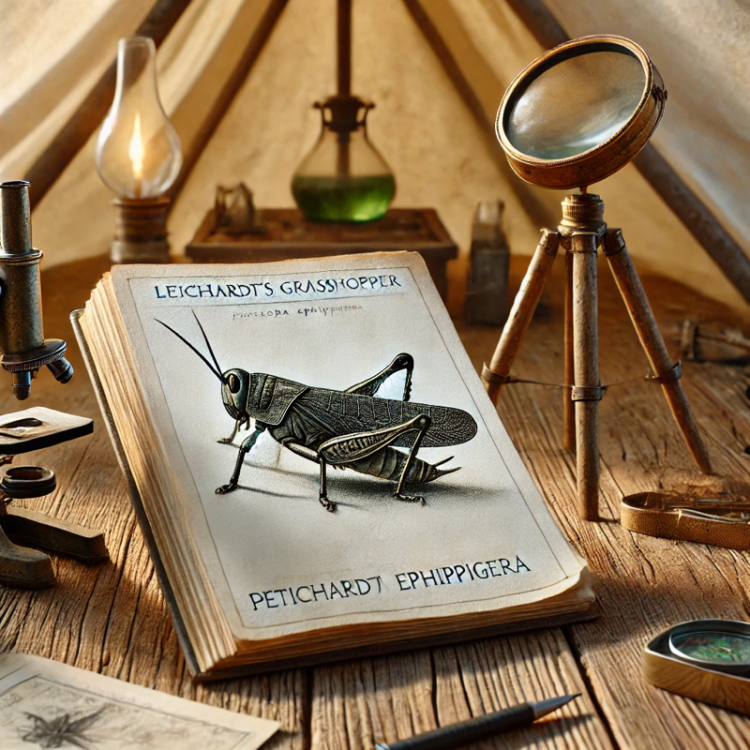Exotic Joy: The Remarkable Design of Leichhardt’s Grasshoppers — a Glimpse of Wonder entry™ —
Deep in Australia’s tropical savannas, a small but vibrant creature brings joy to observers while showcasing one of creation’s most harmonious partnerships. The Leichhardt’s grasshopper (Petasida ephippigera, pronounced Pet-ah-SEE-duh eh-FIP-ih-jeer-ah) spends its entire life on a specific group of plants: shrubs from the Pityrodia genus. This extraordinary relationship highlights the wisdom and care evident in Jehovah’s design of creation.
A Lifelong Home
Leichhardt’s grasshoppers are uniquely tied to the Pityrodia shrubs, native plants of Australia. Unlike many insects that migrate or require multiple habitats throughout their life cycle, these grasshoppers are often content to remain on one shrub. The Pityrodia bush provides them with everything they need—food, shelter, and protection. This lifelong relationship underscores a remarkable level of specialization, reflecting thoughtful design in their interdependence.
The Bitter Protection Plan
The Pityrodia shrub is not just a food source—it’s a shield against predators. Known for its bitter and unpleasant taste, the plant contains compounds that deter herbivores. When Leichhardt’s grasshoppers consume the bush, they absorb its chemical defenses, making them less appealing to predators. The grasshoppers’ bright coloration serves as a warning signal, known as aposematism, alerting predators of their potential toxicity. This mutual benefit protects both the plant and the grasshopper, showcasing a system of survival that is both practical and awe-inspiring.
An Ecological Role
Leichhardt’s grasshoppers contribute to the health and diversity of their ecosystem. By feeding on Pityrodia shrubs, they help manage the plant’s growth, ensuring it doesn’t dominate the landscape. Their vibrant coloration, though a warning to predators, also attracts attention, making them a key species for researchers studying ecological balance and insect-plant relationships. While Pityrodia is their primary food source, they have also been observed feeding on other plants, such as Dampiera conospermoides and Gardenia, demonstrating their flexibility within a specialized niche.
The Pityrodia Shrub: A Perfect Partner
The Pityrodia shrub is a resilient and resourceful plant that thrives in remote sandstone areas of Australia’s Top End region, including Kakadu, Nitmiluk, and Keep River National Parks. Its bitter-tasting leaves protect it from overgrazing, while its ability to sustain Leichhardt’s grasshoppers for their entire lives speaks to its nutrient-rich design. The shrub’s role in this relationship is a testament to the forethought evident in Jehovah’s creations, ensuring survival for both the plant and its insect partner.
Jehovah’s Wisdom in Creation
The unique relationship between Leichhardt’s grasshoppers and the Pityrodia shrub reminds us of Jehovah’s wisdom in creating ecosystems where each organism plays a vital role. As Romans 1:20 states, “For his invisible qualities are clearly seen from the world’s creation onward, because they are perceived by the things made, even his eternal power and Godship.” This partnership demonstrates the balance and care woven into creation, showing us that even the smallest creatures reflect Jehovah’s greatness.
Sources
1. Australian Geographic: Ecology of Leichhardt’s grasshoppers.
2. Journal of Tropical Ecology: Insect-plant relationships in Australian savannas.
3. Encyclopedia of Australian Wildlife: Role of the Pityrodia shrub in native ecosystems.
4. National Geographic: Interdependence in insect-plant relationships.
5. New World Translation of the Holy Scriptures: Romans 1:20.
Edited by dljbsp
- Roxessence and Mike047
-
 1
1
-
 1
1

0 Comments
Recommended Comments
There are no comments to display.
Join the conversation with your brothers and sisters!
You are posting as a guest. If you are already a member, sign in now to post with your existing account.
Note: Your post will require moderator approval before it will be visible.